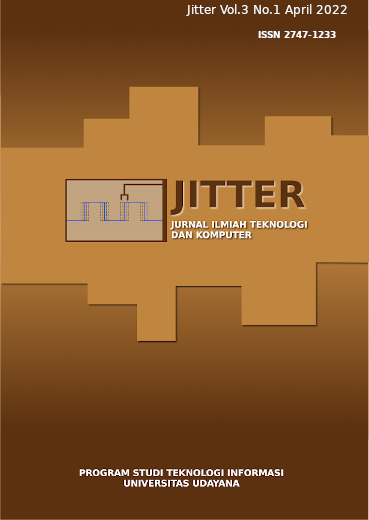Aplikasi Mobile Augmented Reality Cerita Bali: Lubdaka AR
Abstract
Cerita rakyat didefinisikan sebagai cerita dari masa lalu yang diceritakan kembali di masa sekarang. Kurangnya popularitas cerita rakyat dibandingkan dengan cerita dari luar negeri disebabkan oleh orang tua yang jarang meluangkan waktu untuk menceritakan kembali cerita rakyat anak mereka. Selain itu, cerita rakyat tidak disajikan menarik dibandingkan dengan cerita dari luar negeri yang didukung oleh media digital. Di sini, Augmented Reality teknologi dapat digunakan sebagai media pendidikan. Tujuan utama dari Augmented Reality adalah menciptakan lingkungan yang baru dengan cara mengkombinasikan inter aktivitas nyata dengan lingkungan virtual dengan real-time, sehingga bagi pengguna lingkungan yang diciptakan akan terasa nyata. Lingkungan maya dapat dilaksanakan untuk pendidikan karakter dari daerah kearifan dalam cerita rakyat Bali yang berjudul Lubdaka. Kemudian, realitas virtual diterapkan menjadi Augmented Reality dari Cerita Bali: Lubdaka AR. Aplikasi Bahasa Bali Story Lubdaka AR dapat membantu pengguna untuk mendapatkan informasi dan pendidikan tentang pendidikan karakter yang mengandung cerita lubdaka
References
[2] H. S. Wallace, “Augmented Reality: Exploring Its Potential for Extension,” J. Ext., vol. 56, no. 5, 2018.
[3] A. B. Ferliyanto, Adi, Darma Putra, “Augmented Reality Mobile Application of Balinese Hindu Temples DewataA,” MECS Press, no. January, pp. 59–66, 2015.
[4] M. A. Sánchez-Acevedo, B. A. Sabino-Moxo, and J. A. Márquez-Domínguez, “Mobile Augmented Reality,” in Virtual and Augmented Reality, 2018.
[5] S. Evans, “The Impact of Cultural Folklore on National Values: A Preliminary Study with a Focus on Bhutan Introduction There is a story from Central Asia about a man who found a magic cup and learned if he wept into the cup, his tears turned into precious gemstone,” J. Bhutan Stud. bothering, pp. 3–20, 2015.
[6] M. Lunenberg, F. Korthagen, and R. Zwart, “Self Study Research and the Development of Teacher Educators’ Professional Identities,” Eur. Educ. Res. J., vol. 10, no. 3, pp. 407–420, 2011.
[7] J. Bacca, S. Baldiris, R. Fabregat, Kinshuk, and S. Graf, “Mobile Augmented Reality in Vocational Education and Training,” in Procedia Computer Science, 2015. G. Kiryakova, N. Angelova, and L. Yordanova, “The Potential of Augmented Reality to Transform Education into Smart Education,” Tem J., vol. 7, no. 3, pp. 556–565, 2018.
[8] D. Nincarean, M. B. Alia, N. D. A. Halim, and M. H. A. Rahman, “Mobile Augmented Reality: The Potential for Education,” Procedia - Soc. Behav. Sci., 2013.
[9] V. Rotondi, L. Stanca, and M. Tomasuolo, “Connecting alone: Smartphone use, quality of social interactions and well-being,” J. Econ. Psychol., vol. 63, pp. 17–26, 2017.
[10] D. Gayathri, O. K. S, and S. R. C, “Marker Based Augmented Reality Application in Education: Teaching and Learning,” Int. J. Res. Appl. Sci. Eng. Technol., vol. 4, no. Viii, pp. 153–158, 2016.
[11] F. Herpich, R. Luigi, M. Guarese, L. Margarida, and R. Tarouco, “A Comparative Analysis of Augmented Reality Frameworks Aimed at the Development of Educational Applications,” Sci. Res. Publ., pp. 1433–1451, 2017.
[12] S. Mukherjee, P. J. Prakash, and D. Kumar, “Android Application Development & Its Security,” Int. J. Comput. Sci. Mob. Comput., vol. 4, no. 3, pp. 714–719, 2015.
[13] P. Gilski and J. Stefanski, “Android OS: A Review,” Tem J., vol. 4, no. 1, pp. 1–5, 2015.
[14] J. Trojan, S. Chudáček, and P. Chrastina “Augmented reality as a new way of exploring the cit: unified platform for data providers,” WIT Press, vol. 210, 2016. B. Zhang, “Design of mobile augmented reality game based on image recognition,” EURASIP J. Image Video Process., 2017. M. J. Tarr and H. H. Bu, “Image-based object recognition in man, monkey and machine,” ELSEVIER, vol. 67, pp. 1–20, 1998.
[15] D. Anggraeni and H. Barack, “Optimizing 2D Animation Production Time in Creating Traditional Watercolor Looks by Integrating Traditional and Digital Media.”
[16] Q. Wang, “Design of 3D Animation Special Effects in Animation 3D Modeling Teaching Based on QFD Theory,” iJET, vol. 12, pp. 90–100, 2017.
[17] A. Tang, C. Owen, F. Biocca, and W. Mou, “Comparative effectiveness of augmented reality in object assembly,” in Proceedings of the conference on Human factors in computing systems - CHI ’03, 2003.
[1] Postgresql.org. (2021). PostgreSQL: The World’s Most Advanced Open Source Relational Database. The PostgreSQL Global Development Group. https://www.postgresql.org/docs/12/pgtrgm.html




